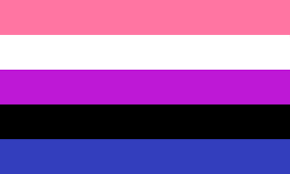genderfluid history? herstory? theirstory? xerstory? ok i'll stop now
hello! this page is about some of the history of genderfluidity!
There is limited available history surrounding genderfluidity. This is partially due to the lack of language describing this experience, as well as transphobia and discrimination towards people who do not follow the binary societal rules of gender.
The first recorded usage of the term genderfluid was in 1987, and the first dictionary entry for the word was on January 21st, 2007, in the Urban Dictionary. The word is a compound word created from the words 'gender' and 'fluid', in description of having a fluid and changing gender. People fitting the definition of what we currently call genderfluid definitely existed before the word (which is why the word exists!), but used different terminology to describe their experiences.
Some of those people considered themselves to be "occasional crossdressers", "part time transvestites", "half-male, half-female", or as being able to switch between genders.
Today, those descriptions have mostly fallen out of usage and the most common label for this experience is simply 'genderfluid'.
The most common genderfluid flag, shown below, was debuted and presented on Aug 3rd, 2012 by JJ Poole. Prior to this flag, there was no "official" or known flag for genderfluid pride. It was designed specifically to be a pride flag and represent people whose gender identity is fluid and fluctuates at different times or in different circumstances. The flag represents the diversity of genderfluidity, genderfluid identities, and the genderfluid community. It has five stripes of equal thickness, and each has a different color. In order from top to bottom, the stripes are pink, white, purple, black, and blue. Each stripe has a significance and meaning. Pink is representative of femininity, feminine genders, and femaleness. White represents a lack of gender and genderlessness. Purple represents combinations of masculinity and femininity, as well as androgyny. Black is representing all other genders, unnamed genders, and multigender. Lastly, blue represents masculinity, masculine genders, and maleness.

There are alternative flags representing genderfluidity, but none of them have reached the popularity of the original, and are less commonly known.
